The current situation of Bitcoin expansion: What kind of system can be called L2?

Reprinted from panewslab
05/08/2025·16DAuthor: Botanix Labs
Original link: https://botanixlabs.xyz/en/blog/the-current-landscape-of-bitcoin-scaling
In the process of developing Botanix, we are constantly asking ourselves a question: Can a system built on Bitcoin really be called a sidechain or layer two (L2)? This is a complex problem because from a technical point of view, based on current capabilities, Bitcoin cannot act as a real L1 to carry L2 like other ecosystems. Typically, L2 relies on smart contracts deployed at the underlying layer to verify proofs. For example, in the Ethereum ecosystem, the verification of L2 is performed by a deterministic function in a smart contract, which is executed by all Ethereum nodes when processing transactions.
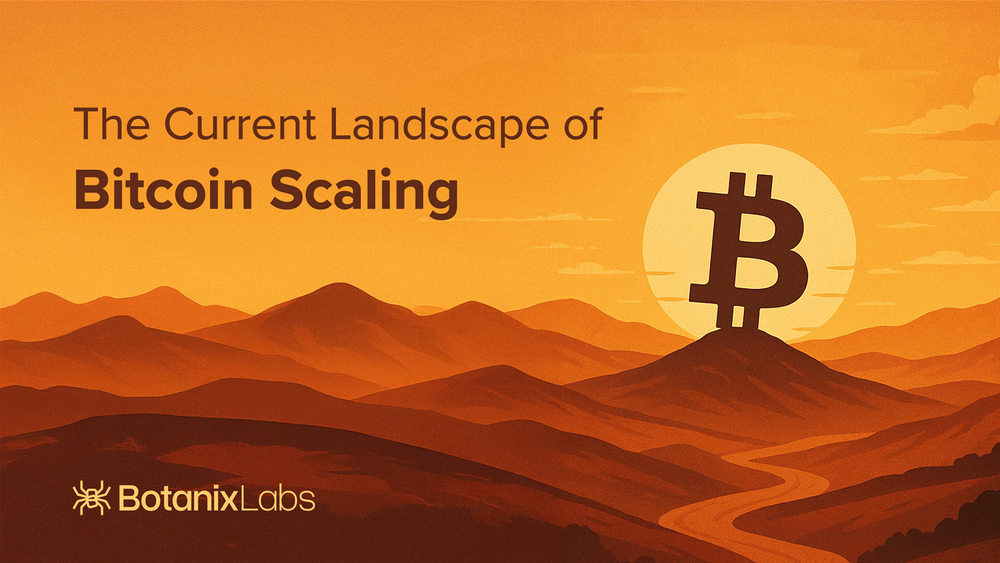
The situation in Bitcoin is both simpler and more complicated. Discussions about L2 on Bitcoin are often confusing. Unlike Ethereum, which natively supports Turing's completeness and expression capabilities, Bitcoin's current capabilities are extremely limited, and what are technically feasible and what are not feasible are full of subtle differences. Because of this, systems built on Bitcoin do not actually have the L2 or sidechain functions in the strict sense. So why do we prefer to call it "Bitcoin Chains" rather than extensions or layer two (L2)? The reason is that these chains built on Bitcoin usually have independent operating logic and build their own ecosystems around it.
Bitcoin does not support smart contracts like Ethereum. Any complex logic must be achieved by constructing a structure on it. Therefore, Bitcoin itself cannot directly verify the proof, nor can it maintain the status of the smart contract. Most types of proofs are too large to be chained – Bitcoin transactions are only allowed to carry 80 bytes of arbitrary data. Starkware-like m31 solutions are highly specialized and closed. Even if you manage to post some kind of proof or status update to Bitcoin, the process is more like Optimistic Rollups. But waiting for a full week to resolve fraud proof is neither realistic nor acceptable; relying on third-party bridges introduces delay and trust assumptions, both of which are not ideal in the Bitcoin native environment.
Interaction with Bitcoin is limited to unconsumed transaction output (UTXO) with ScriptPubKey and transfer transactions with BTC. The OP_RETURN instruction can only carry 80 bytes of data and cannot support the interaction of complex data structures at all. Because of these limitations, it is difficult to get Bitcoin to have full L1 support for L2 unless there is a significant change in the protocol (such as a hard fork). Such modifications not only require extremely high community consensus, but may also damage the uniqueness and value positioning of Bitcoin as an asset. For example, proposals to introduce new directives such as OP_CAT (such as CatVM) have not yet reached a broad consensus. Even if there is a consensus, it often takes years for a BIP (Bitcoin Improvement Proposal) to be proposed to activated.
Because of this, Botanix’s goal is to build on “current Bitcoin” rather than trying to force it into L1, or push for radical protocol changes. This path is possible because we use Spiderchain technology and a network of coordinators. So, to what extent has the ecosystem being built on Bitcoin developed?
Background: Emerging Scenario of Bitcoin Chain (L2)
Despite the objective existence of the above limitations, most projects still tend to call themselves "L2" and use this term as a general label. One of the first projects to claim to be Bitcoin L2 was Stacks. While Stacks anchors data to Bitcoin and interacts with BTC, it is essentially an independent blockchain with its own consensus mechanism. Another example is BounceBit, which is classified as Bitcoin L2 because of its consensus mechanism using BTC (along with native tokens). But this is actually not accurate. Architecturally, it is closer to a restaking model, running on its own chain, and the role of Bitcoin is limited to indirect participation.
However, the vision of making Bitcoin "live" - making it more than just a store of value tool, but an asset that can "do more things" has long attracted the attention of many developers. With a new super cycle that begins in 2022, this vision has become increasingly important. Although Ethereum has increased by about 4 times from bottom to top in this cycle, Bitcoin has increased by 6 times despite being slower and more "cumbersome". This dynamic is very interesting, isn't it? It further strengthens Bitcoin’s position as a dominant asset in the Web3 world.
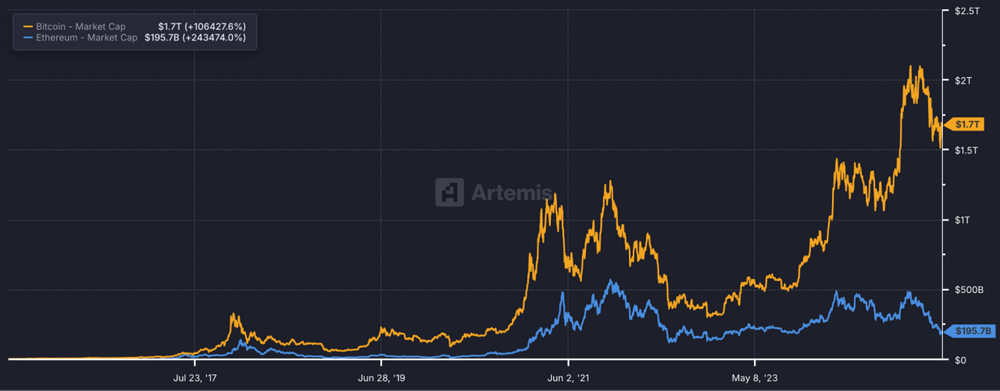
Source: [_https://app.aremis.xyz/_](https://app.artemis.xyz/)
Judging from the value utilization indicators such as TVL (total value of locked positions) - this indirectly reflects the degree of use of underlying assets in the ecosystem - the comparison between Bitcoin and other networks is more significant. TVL represents the value carrying capacity of an ecosystem, including the application of its upper layer construction and the utilization of underlying assets in L2 running on the basic chain.
Currently, Bitcoin has only $5.5 billion in TVL in decentralized applications, while its FDV (full dilution valuation) is as high as an astonishing $1.74 trillion. This means that only a very small part of the value of Bitcoin is truly utilized on-chain. In contrast, Ethereum has a TVL of US$48.9 billion in DeFi application and staking infrastructure (such as Lido, EigenLayer, Rocket Pool, etc.), which is already a considerable proportion of assets actively participating in the ecosystem operation compared to its US$228 billion FDV.
By comparison, the gap is clear at a glance. Solana's TVL is also at a higher level compared to its FDV - $8.25 billion vs. $76 billion. You will know this gap! Solana is 8.25 billion vs 76 billion, while Bitcoin is 5.8 billion vs 1.73 trillion! This is a reflection of the huge growth potential of the Bitcoin ecosystem in terms of value utilization.
Public chain
|
Complete dilution valuation (FDV)
|
Total value of locked positions (TVL)
|
TVL/FDV ratio
---|---|---|---
Ethereum
|
$228 billion
|
$48.9 billion
|
≈ 21.45%
Solana
|
$76 billion
|
$8.25 billion
|
≈ 10.86%
Bitcoin
|
1.74 trillion US dollars
|
$5.8 billion
|
≈ 0.33%
Source: DefiLlama, Coinmarketcap
It's indeed a very sharp contrast, isn't it? This precisely highlights the huge upward space in the Bitcoin ecosystem - it is this potential that attracts protocol developers like Botanix to build projects on top of Bitcoin.
At the same time, there are also some factors that while promoting technological innovations like Botanix, it may in turn slow down the development of the entire Bitcoin ecosystem. This "paradox" is reflected in the typical mentality of BTC holders: They are used to storing assets in cold wallets for a long time, rather than interacting with protocols as frequently as Ethereum's DeFi users. Compared with Ethereum users actively participating in pledge, lending, liquidity mining and other activities, BTC holders attach more importance to asset security and self-management, and highly adhere to the fundamental values of Bitcoin.
This is also one of the reasons why many "synthetic BTC" or "cross-chain BTC" versions based on non-bitcoin native chains have always been difficult to obtain mainstream adoption. Bitcoin users generally lack trust in the ecosystem on non-native chains, believing that it is not something that really "anchors" the Bitcoin network.
The intrinsic value of BTC is mainly reflected in its "long-term value storage" function. Data shows that about 60% to 70% of Bitcoin have not experienced on-chain transfers in the past year, and this proportion continues to rise, reflecting the solid existence of long-term holders (HODLers). In November 2024, the proportion hit a new high, reaching 70.54%, although this figure dropped slightly during the subsequent rise in BTC prices.
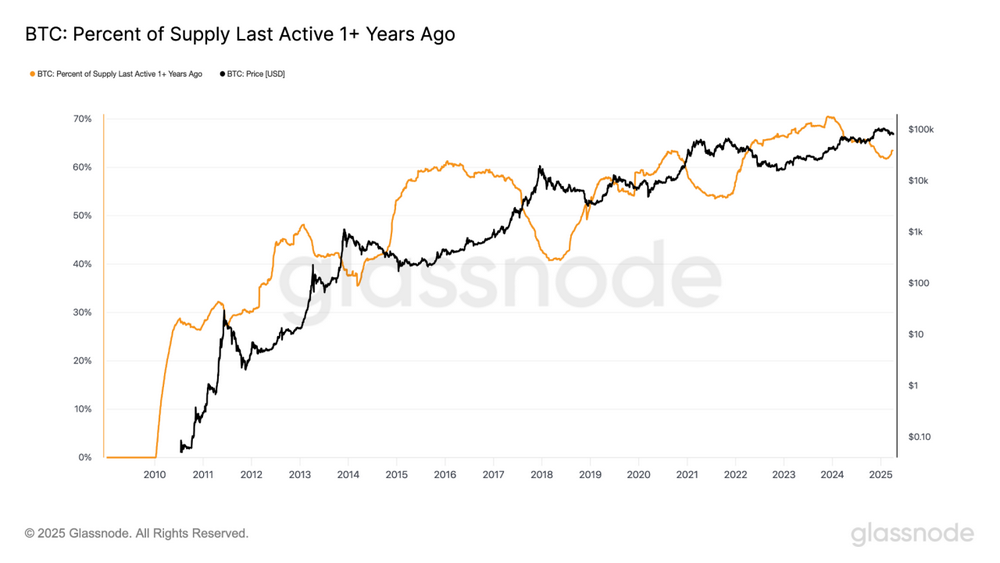
Source: [_https://studio.glassnode.com/charts/supply.ActiveMore1YPercent?a=BTC &category=&zoom=all_](https://studio.glassnode.com/charts/supply.ActiveMore1YPercent?a=BTC&category=&zoom=all)
In addition, the global trend chart of Long-Term Holder Supply and Spent Output Profit Ratio (SOPR) also shows a trend of sustained growth. This shows that Bitcoin is attracting more and more long-term holders, further consolidating the value of BTC as a "long-term wealth storage tool". The root of this trend is that the Bitcoin blockchain is currently the most decentralized, robust, trustless and censor-resistant network, and it is these characteristics that ensure that BTC becomes one of the safest assets in the world.
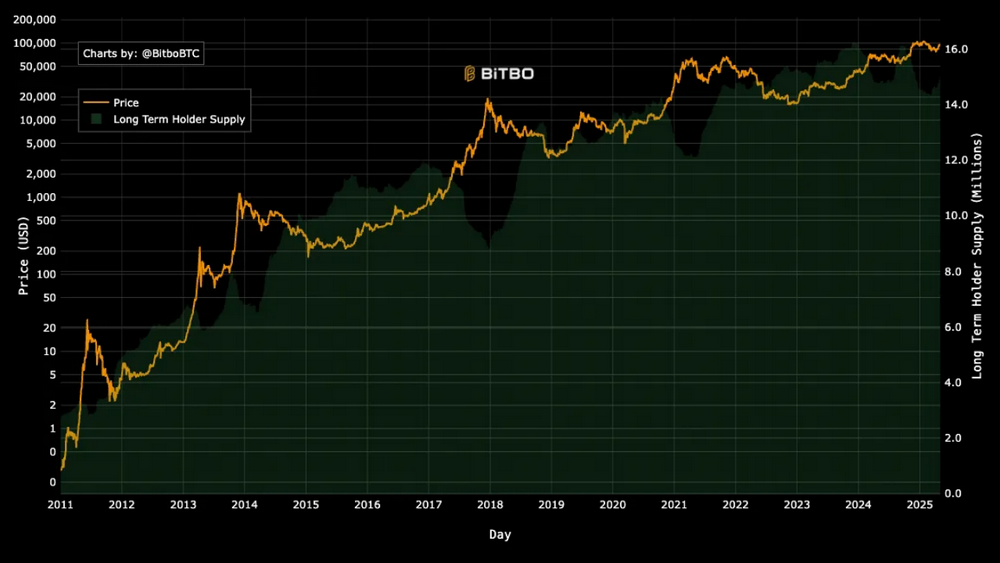
Source: [_https://charts.bitbo.io/long-term-holder-supply/_](https://charts.bitbo.io/long-term-holder-supply/)
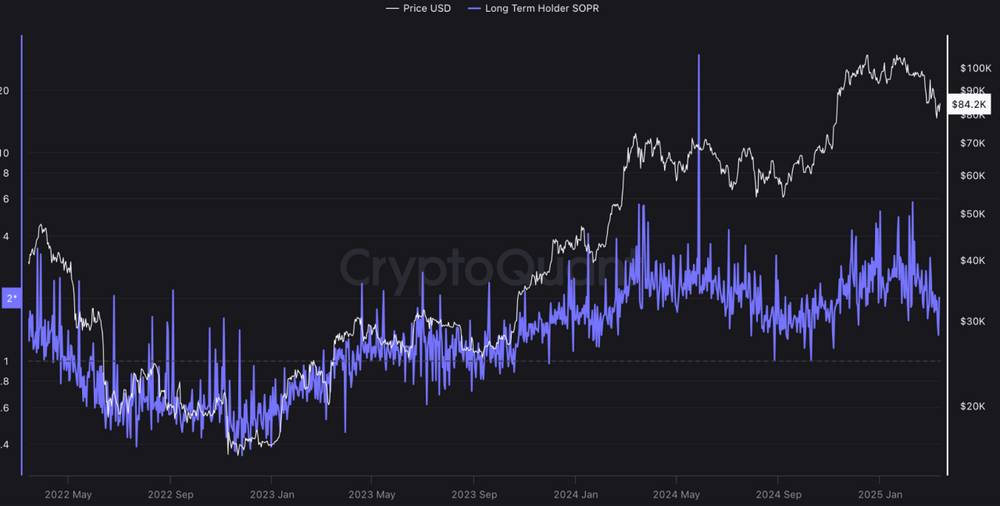
Source: [_https://charts.bitbo.io/long-term-holder-supply/_](https://charts.bitbo.io/long-term-holder-supply/)
From another perspective—these dynamic changes also remind us that new Bitcoin holders may begin to see BTC as a “circulating asset” rather than a purely stored value product. But the question is: Are these users willing to deal with packaged assets (such as WBTC), or are they still preferring to use "native Bitcoin" more directly? To answer this question, we need to take a look at the current development trend of the Bitcoin Chains (Bitcoin Chains/L2) ecosystem in the above context.
Bitcoin Chains (L2) ecosystem is taking off
Initially, the development of the ecosystem on Bitcoin was far ahead of Ethereum's history of expansion through Layer 2. The Lightning network appeared three years earlier than Plasma and five years earlier than the earliest rollup, and has made progress in the scalability of decentralized payments. But it inherits many design limitations, such as interactivity (users must be online to receive payments), payment routing complexity in multi-party scenarios, and complex deposit and withdrawal liquidity requirements.
Some of the problems were alleviated by another Layer 2 protocol called ARK. ARK introduced ASP (Ark Service Provider) to settle payments between users in a private manner, while still allowing Bitcoin to be redeemed without trust on the main chain. However, ARK still faces interactive limitations due to the fact that the covenant (contract) mechanism has not been introduced, and its high demand for capital also makes the protocol inefficient.
Previously, these Bitcoin-based chains did work in payment scenarios, but they still face expansion bottlenecks and have hardly tried to add additional features to Bitcoin. Subsequently, more complex and functional designs emerged. Meanwhile, some complex solutions are also developing in parallel: Rootstock was launched in 2015, while Stacks dates back to 2013. However, their development road is long.
Until two years ago, Bitcoin's presence in decentralized applications was still weak. At the beginning of 2023, only hundreds of millions of dollars of BTC were deployed in DeFi - compared to Bitcoin's huge market value, this is just a drop in the ocean. But by 2024, everything has changed. The first projects that attempted to introduce programmability for Bitcoin include Rootstock and Stacks. According to DefiLlama, in the first half of 2024, Rootstock hosted approximately $294 million in BTC, while Stacks hosted approximately $289 million, with the two totaling $570 million. In 2024, with the addition of new players, the pattern of the Bitcoin ecosystem has undergone major adjustments. In February 2024, Rootstock and Stacks accounted for more than 94% of the total lockout volume (TVL), but by March 2025, this pattern had become much more diversified.
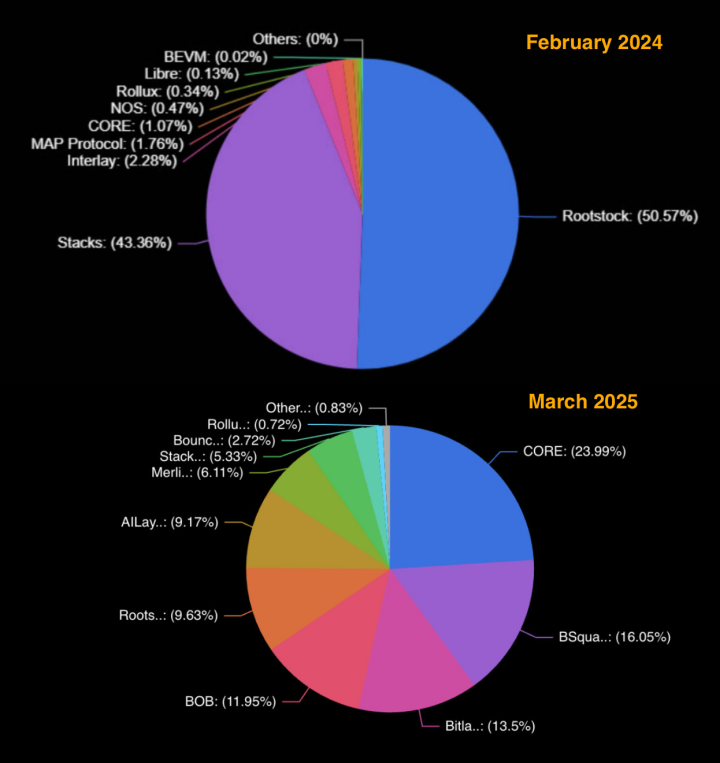
Source: DefiLlama data, [_en.coin-turk.com_](http://en.coin-turk.com)
Against this backdrop, by the end of 2024, the total on-chain lockout volume of Bitcoin (TVL) surged by more than 20 times - from US$307 million in January 2024 to US$6.5 billion in December, a surge of more than 2,000% in one year. This is not just growth, but a real explosion of Bitcoin in the on-chain financial field. TVL began to rise in October 2024 and peaked at $7.39 billion in December. Why did all this happen?
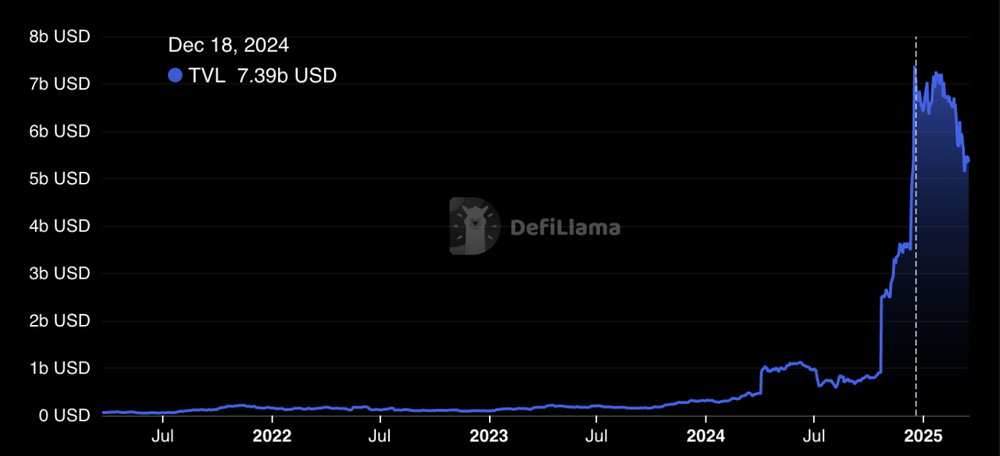
Source: DefiLlama
In 2024 alone, the growth of the Bitcoin ecosystem was as high as 600%, with the total locked BTC exceeding 30,000, which is equivalent to nearly US$3 billion of assets being actively used in various expansion solutions. The information is very clear - Bitcoin is evolving. It is no longer just a means of storage of value, but has gradually become an indispensable part of the on-chain economy.
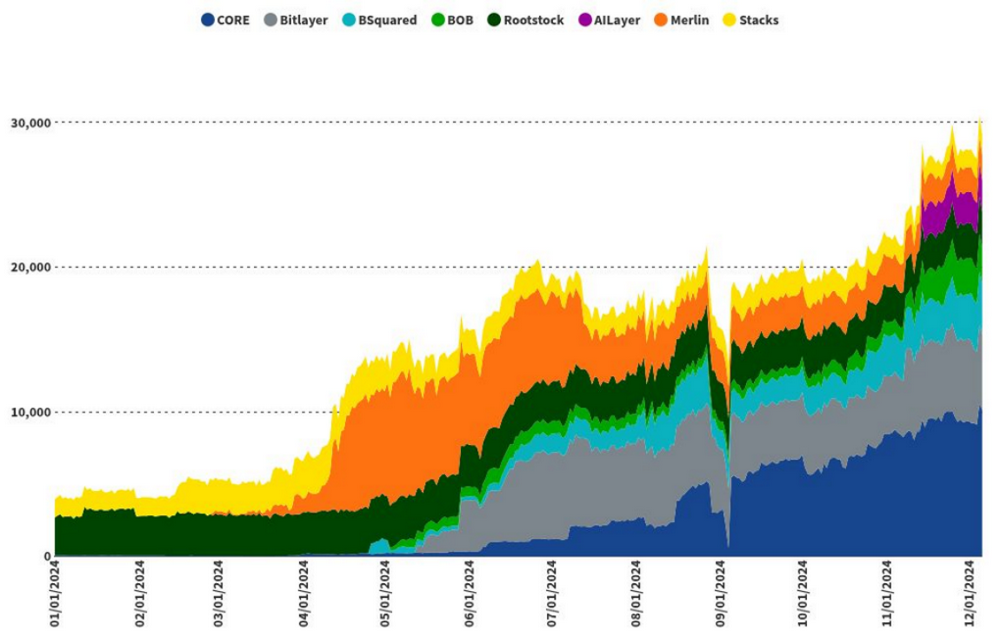
Source: [_https://www.vaneck.com/corp/en/news-and-insights/blogs/digital-assets/matthew-sigel-vanecks-10-crypto-predictions-for-2025/_](https://www.vaneck.com/corp/en/news-and-insights/blogs/digital-assets/matthew-sigel-vanecks-10-crypto-predictions-for-2025/)
Meanwhile, Rootstock and Stacks' market positions began to decline, gradually being replaced by more advanced and functional protocols. Bitcoin’s programmable layer solutions are rapidly erupting, pushing Bitcoin DeFi into a new era. According to L2Watch, more than 75 Bitcoin-based projects are under development today, covering EVM-compatible chains, rollup solutions and newly designed side chains. These projects have only one common goal: to unleash the huge liquidity of Bitcoin and integrate it into the broader DeFi ecosystem.

Source: [_L2.Watch_](https://l2.watch/) data
With the diversification of protocols, the capacity of the Bitcoin ecosystem has also increased. This field has gone through a long journey—from network overlays initially used for payments (such as Lightning) to a complex chain ecosystem that now provides multiple capabilities. But the key challenge is not just to build a chain that provides new possibilities for Bitcoin users, but also how to retain the native features and security of Bitcoin in the process. This is much more complex than building cross-chain bridges or synthetic assets simply through casting and destruction mechanisms. Botanix solves this problem through Spiderchain technology and the coordinator network, thus maintaining direct connection and continuity to the Bitcoin mainnet.
The evolution of these technologies drives Bitcoin from "Hold (HODL)" to "Yield": entering the DeFi and Real-World Assets (RWA) scenario. Botanix's goal is to achieve this "intelligent use of Bitcoin" without departing from the Bitcoin main chain itself. Bitcoin chain solutions equipped with smart contracts now support on-chain lending, transactions and earnings generation, and are gradually replicating Ethereum's DeFi system. This allows BTC holders to earn earnings or use BTC as collateral without relying on centralized custodians. As VanEck pointed out, such chain and abstract technologies will transform Bitcoin from a passive store of value to a member of an active participant in the decentralized ecosystem, further unleashing liquidity and promoting cross-chain innovation.
Conclusion
Therefore, Bitcoin is no longer just a "digital gold" stored in a cold wallet. We are standing at the starting point of a new era of Bitcoin. An era where Bitcoin’s liquidity, security and trustworthiness jointly reshape the decentralized financial landscape.
And the most exciting thing is that it's just beginning.



 jinse
jinse